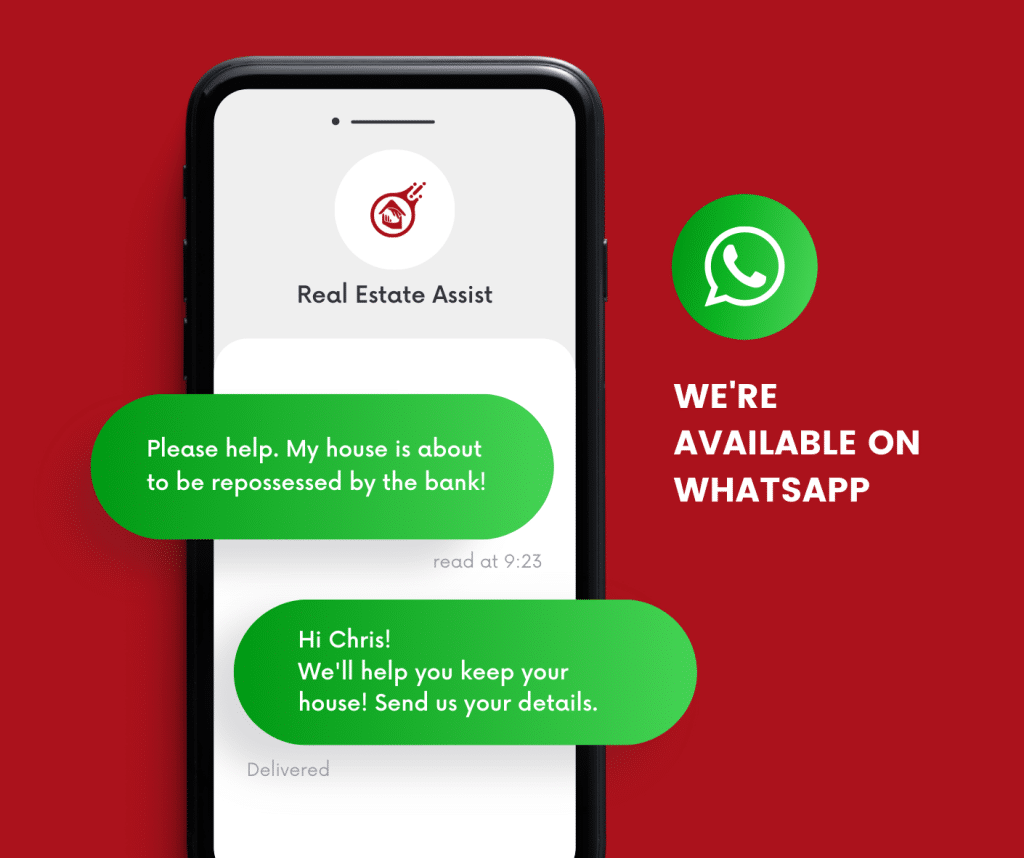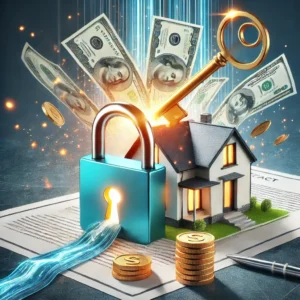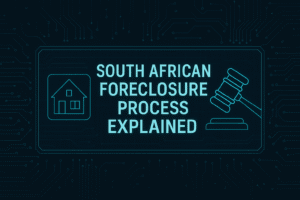Table of Contents
Stop Home Repossession in South Africa
When you face Stopping home repossession it’s a serious issue that can have devastating consequences for homeowners and their families. If you’ve received a repossession notice from your lender, it’s important to take action as soon as possible to avoid losing your home.
Repossession is a legal process that allows lenders to take possession of your property if you fail to keep up with your mortgage payments. This can have serious consequences, including damage to your credit score and difficulty in obtaining loans or mortgages in the future.
Fortunately, there are several options available to stop home repossession. One option is negotiating with your lender to find a solution that works for both parties. Another option is selling your property before the repossession process begins. Contact Real Estate Assist for the best solution for you with a FREE consultation to determine what will be best for you and your family. Real Estate Assist has plenty of solutions for these situations and has stopped many repossessions and helped many homeowners recover.
In addition, there are government schemes available that can help homeowners facing repossession. These schemes provide financial assistance and advice on how to manage debt and avoid losing your home.
It’s important to act fast when facing repossession and seek professional advice from experts who specialize in this area. They can help you find the best solution for your situation and ensure that you don’t lose your home.

Understanding the House Repossession Process and Timeline
House repossession process can be a daunting and stressful experience for homeowners who have missed their mortgage payments. It is essential to understand the timeline and process of house repossession to avoid losing your home. In this section, we will discuss the house repossession process in detail, including when it starts, how it progresses, and what happens during the hearing.
The House Repossession Process Starts When You Miss Your Mortgage Payments
The house repossession process begins when you miss your mortgage payments. The number of missed payments required to start the process varies depending on the lender and type of mortgage. Typically, lenders wait for two or three missed payments before starting the repossession proceedings.
Repossession Proceedings Can Begin After Two to Three Missed Payments
Once you have missed two or three mortgage payments, your lender will send you a default notice. This notice informs you that you have breached your mortgage agreement and gives you a deadline to pay the arrears. The deadline is usually 14 days from the date of the notice.
If You Fail To Pay The Arrears Or Come To An Agreement With The Lender, They Will Apply For A Possession Order
If you fail to pay the arrears or come to an agreement with your lender within 14 days, they will apply for a possession order from the court. This application starts the formal legal proceedings for house repossession.
A Hearing Will Be Scheduled Where You Can Present Your Case To The Court
Once your lender has applied for a possession order, a hearing will be scheduled at court. At this hearing, both parties will present their case before a judge who will make a decision based on evidence presented.
It is important to attend this hearing as it provides an opportunity for you to explain why you fell behind with your mortgage payments and what steps you are taking to resolve any issues. If there are any extenuating circumstances that led to payment difficulties such as job loss, illness, or relationship breakdown, it is essential to bring them to the court’s attention.

If The Court Grants The Possession Order, You Will Have To Leave Your Home Within A Set Time Frame
If the court grants the possession order, you will have to leave your home within a set time frame. This time frame varies depending on the circumstances of each case and can range from 14 days to several months. It is crucial to seek legal advice if you are facing house repossession as there may be options available that can help you keep your home.
Understanding the Timeline of the House Repossession Process
The timeline for the house repossession process varies depending on many factors such as how quickly you respond to default notices and whether you attend court hearings. Typically, it takes around six months from missing your first payment to losing your home.
During this period, it is essential to communicate with your lender and seek professional advice from housing charities or solicitors who specialize in mortgage arrears. They can provide guidance on how best to deal with arrears and help negotiate an affordable repayment plan with your lender.
It is important not to ignore any communication from your lender during this period as they may take legal action against you without further notice if payments remain outstanding. Keeping track of all correspondence and seeking professional advice can help prevent this situation from escalating.
What Happens After You Lose Your Home?
After losing your home through repossession proceedings, you may still owe money to your lender if the sale of your property does not cover all outstanding debts. This debt is known as a shortfall debt and can be significant depending on how much was owed on the mortgage at the time of repossession.
It is important to seek professional advice after losing your home as there may be options available that can help reduce or write off any shortfall debt. Housing charities such as Shelter or Citizens Advice Bureau can provide free advice on dealing with shortfall debts and negotiating affordable repayment plans.

Can Bankruptcy Help Stop Repossession? Yes, Here’s How.
Bankruptcy can be a viable option for stopping home repossession. If you’re facing foreclosure, filing for bankruptcy can put an automatic stay on all collection activities, including foreclosure proceedings. This means that your lender cannot continue with the foreclosure process while your bankruptcy case is pending. The automatic stay gives you time to catch up on missed mortgage payments through a repayment plan, which can help you keep your home.
Chapter 13 bankruptcy is particularly useful for stopping home repossession. It allows you to restructure your debts and create a manageable repayment plan over three to five years. This type of bankruptcy is also known as a wage earner’s plan because it requires you to have a steady income to make payments toward your debts.
When you file for Chapter 13 bankruptcy, you’ll work with a court-appointed trustee who will oversee your case. The trustee will review your finances and help you develop a repayment plan that fits within your budget. You’ll make monthly payments to the trustee, who will distribute the funds to your creditors according to the terms of the plan.
One of the benefits of Chapter 13 bankruptcy is that it allows you to keep your assets, including your home. As long as you continue making payments under the repayment plan, you’ll be able to keep your property and avoid repossession or foreclosure.
It’s important to note that bankruptcy should only be considered as a last resort when facing home repossession or any other financial difficulty. Bankruptcy can have long-lasting effects on your credit score and financial future, so it’s crucial to speak with a qualified bankruptcy attorney before making any decisions.
Bankruptcy stays on your credit report for up to ten years and can make it difficult or impossible to obtain credit in the future. However, if you’re facing imminent repossession or foreclosure and don’t have any other options available, filing for bankruptcy may be necessary.
In addition to putting an automatic stay on collection activities and allowing you time to catch up on missed mortgage payments, bankruptcy can also provide relief from other types of debt. For example, if you have credit card debt or medical bills that you’re struggling to pay, Chapter 13 bankruptcy can help you restructure these debts and make them more manageable.
Making a New Payment Proposal to Stop Repossession
If you are facing repossession, making a new payment proposal is one of the best ways to stop it. A payment proposal can include a repayment plan, a new loan, or even a free cash offer to pay off any arrears or rent owed. It’s important to act quickly and make payments on time to avoid a possession order or voluntary repossession.
Repossession is the process by which your lender takes back your property because you have failed to keep up with repayments. This can happen with any type of asset that has been used as collateral for a loan, including cars, boats, and homes. If you are facing repossession, it’s important to take action as soon as possible.
One option for stopping repossession is to make a new payment proposal. This involves contacting your lender and proposing an alternative payment plan that will allow you to catch up on missed payments and keep your property. There are several different types of payment proposals that you can make depending on your financial situation.
Repayment Plan
A repayment plan involves spreading out the missed payments over a longer period of time so that they become more manageable. For example, if you have missed three mortgage payments of $1,000 each, you could propose paying an extra $300 per month for the next ten months in addition to your regular mortgage payment.
This type of payment plan is often the most feasible option for homeowners who have experienced temporary financial difficulties but expect their income to increase in the future. It allows them to catch up on missed payments without having to come up with a large lump sum all at once.
New Loan
Another option for stopping repossession is taking out a new loan with lower monthly payments than what you currently owe. This can be done either through refinancing or securing another form of credit such as an unsecured personal loan.
Refinancing involves taking out a new mortgage with a lower interest rate and longer repayment term. This can result in significantly lower monthly payments, making it easier to keep up with repayments.
An unsecured personal loan is another option for those who do not qualify for refinancing or do not want to put their home at risk. These loans typically have higher interest rates than secured loans, but they can be used to pay off arrears and catch up on missed payments.
Free Cash Offer
In some cases, lenders may be willing to accept a free cash offer to pay off any arrears or rent owed. This involves finding a third-party investor who is willing to lend you the money needed to catch up on missed payments.
This option is often only available if you have significant equity in your property or if the lender believes that repossession would result in a loss for them. It’s important to note that this type of payment proposal requires finding an investor quickly and negotiating terms that are favorable for both parties.

Act Quickly
Regardless of which payment proposal you choose, it’s important to act quickly and make payments on time. If you fail to do so, your lender may seek a possession order or voluntary repossession of your property.
A possession order allows your lender to take legal action against you in court and seize your property if necessary. Voluntary repossession involves handing over the keys and allowing the lender to sell the property without going through the courts.
Both options can have serious consequences for your credit score and future ability to obtain credit. It’s therefore essential that you take steps as soon as possible if you are facing repossession.
Ask the Court to Dismiss the Case or Allow You to Stay
Court proceedings for home repossession cases can be daunting, but it’s important to remember that you have legal rights and options available to you. If you’re facing a court hearing for home repossession, it’s crucial to seek legal advice and get help from professionals who understand the legal process and can guide you through it.
Depending on your situation and the laws in your state, you may be able to ask the court to dismiss the case or allow you to stay in your home. This can be done by submitting a defense form or presenting your case in court.
Submitting a Defence Form
If you receive a letter from the court stating that a repossession hearing will take place, it’s essential that you act quickly. You’ll need to complete and return a defense form within 14 days of receiving the letter. The defense form is also known as an N11M form.
The purpose of this form is to explain why you shouldn’t lose your home. You’ll need to provide details about your financial situation, including any income or benefits that you receive. It’s important that this information is accurate because if it isn’t, the judge may not believe what you say.
You’ll also need to explain why losing your home would cause hardship for yourself or anyone else living with you. For example, if someone in your household has a medical condition that requires them to live in their current property, this should be included on the form.
Presenting Your Case in Court
If your defence form is accepted by the court, there will be a hearing where both parties (you and the lender) will present their cases before a judge. At this point, it’s essential that you have all relevant documents with you so that they can be presented as evidence.
Documents such as mortgage statements, bank statements showing payments made towards mortgage arrears, proof of income (such as payslips), and any correspondence between yourself and the lender are all important pieces of evidence.
It’s also a good idea to prepare answers to potential questions that may arise during the hearing. This will help you feel more confident and ensure that you’re able to present your case in the best possible way.
Getting Help
If you’re feeling overwhelmed or unsure about how to proceed, don’t hesitate to contact legal professionals or organizations that specialize in helping people facing home repossession. They can provide valuable support and guidance throughout the process.
Legal aid is available for repossession cases, although it’s important to note that this is means-tested. This means that if you have a job, you may not be eligible for legal aid. However, there are still many organizations and charities that offer free advice and support.
For example, Shelter is a charity that provides free advice on housing issues. They have a helpline where you can speak to an advisor who will be able to provide information on your rights and options.
Citizens Advice is another organization that offers free advice on a wide range of issues, including housing. They have local offices across the UK where you can speak to an advisor face-to-face.
Five Ways to Avoid Vehicle Repossession: Tips and Strategies
Negotiate with the Lender
Car owners who are struggling to make payments on their vehicle loan should contact their lender as soon as possible. Discussing other options, such as a loan modification or deferment of payments, can help prevent repossession and allow car owners to keep their vehicle. It is important to act quickly and not wait until the last minute to negotiate with the lender. Waiting too long can result in repossession and damage to credit scores.
Sell the Vehicle
If a car owner cannot afford to make payments on their vehicle, selling it may be a viable option. This can help pay off the remaining balance on the loan and avoid repossession. However, it is crucial to act quickly before the lender takes possession of the vehicle. Selling a vehicle that has already been repossessed will not eliminate debt owed on it.
Consider Refinancing
Refinancing a vehicle loan can help lower monthly payments and make them more manageable for car owners. This option can also help prevent repossession and allow car owners to keep their personal property. Refinancing may be an excellent solution for those who have improved credit scores since taking out their initial loan or have found better interest rates elsewhere.
Participate in a V4 Program
Some lenders offer voluntary surrender programs, also known as v4 programs, which allow car owners to return their vehicle without going through repossession. Participating in this program can help avoid damage to credit scores and allow car owners to retain their driver’s license. However, it is essential to understand that participating in this program does not eliminate debt owed on the vehicle.
Seek Legal Assistance
Car owners who are facing repossession may benefit from seeking legal assistance from an attorney experienced in dealing with these types of cases. An attorney can help negotiate with the lender and explore other options available for preventing repossession of both vehicles or personal property.
Rebuilding Credit After Repossession: Tips and Advice
Check Your Credit Report Regularly
One of the first steps to rebuilding credit after repossession is to check your credit report regularly. This will help you identify any errors or discrepancies that may be negatively impacting your credit score. You can obtain a free copy of your credit report from each of the three major credit bureaus once a year by visiting annualcreditreport.com. It’s important to review your report for inaccuracies, such as accounts that don’t belong to you or incorrect balances.
Consider Applying for a Secured Credit Card
Another way to rebuild credit after repossession is by applying for a secured credit card. A secured card requires a security deposit, which serves as collateral in case you default on payments. The amount of the deposit typically determines the limit on the card. Using a secured card responsibly can help you establish a positive payment history and improve your credit score over time.
Apply for a Credit-Builder Loan
A credit-builder loan is another option for those looking to rebuild their credit after repossession. These loans are designed specifically for people with poor or no credit history and work by allowing you to borrow money that’s held in an account while you make monthly payments toward it. Once the loan is paid off, you’ll receive the funds plus interest, and your timely payments will be reported to the major credit bureaus.
Pay Bills On Time and In Full
Paying bills on time and in full is crucial when working to rebuild your credit after repossession. Late payments can have a significant negative impact on your score, so it’s important to prioritize paying bills on time every month. If possible, consider setting up automatic payments or reminders so that you never miss a due date.
Avoid Opening Multiple New Credit Accounts at Once
While opening new lines of credit can help improve your overall available credit and potentially boost your score, it’s important not to open too many accounts at once. Doing so can be seen as a red flag by lenders and may actually hurt your score. Instead, focus on using one or two accounts responsibly and paying them on time every month.
Be Patient and Persistent
Rebuilding credit after repossession is not a quick process, but it’s important to stay patient and persistent in your efforts. It may take several months or even years to see significant improvements in your score, but don’t get discouraged. As long as you’re consistently making payments on time and avoiding new negative marks on your report, you’ll eventually see progress.
Use Credit Responsibly
Once you’ve started rebuilding your credit after repossession, it’s important to continue using credit responsibly. This means only charging what you can afford to pay off each month and avoiding maxing out your cards or taking on too much debt. By maintaining responsible financial behavior over time, you’ll be able to continue improving your credit score and eventually qualify for better rates and terms on loans.
Monitor Your Progress
Finally, it’s important to monitor your progress as you work to rebuild your credit after repossession. Keep an eye on your credit report regularly and track changes in your score over time. Celebrate small victories along the way, such as paying off a debt or seeing a slight increase in your score. By staying focused on the end goal of achieving good credit, you’ll be more motivated to make smart financial decisions along the way.
Reduce Payments on Home Loans Without Risking Repossession
Homeowners facing financial difficulties can reduce their monthly mortgage payments without risking repossession. Mortgage lenders may offer home loan modification programs that allow borrowers to adjust their mortgage repayment terms. These modifications can include lowering interest rates, extending the loan term, or even forgiving missed payments.
It’s important for homeowners to be proactive and communicate with their lender as soon as possible if they are struggling to make payments or have fallen into mortgage arrears. Many lenders are willing to work with borrowers to find a solution that allows them to keep their homes and make payments they can afford.
Contacting Your Mortgage Provider
If you’re having trouble making your mortgage repayments, the first step is to contact your mortgage provider. They will be able to advise you on what options are available and how you can reduce your monthly payments without risking repossession.
It’s important not to ignore any letters or phone calls from your lender as this could lead to legal action being taken against you. By contacting them early, you’ll show that you’re willing to work with them and find a solution that works for both parties.
Home Loan Modification Programs
One of the most common ways of reducing monthly mortgage payments is through a home loan modification program. This involves changing the terms of your original loan agreement in order to make it more affordable.
There are several different types of home loan modification programs available, including:
- Interest rate reduction: This involves lowering the interest rate on your mortgage, which will result in lower monthly repayments.Loan term extension: Extending the length of your loan term will also reduce your monthly repayments.Forgiveness of missed payments: Some lenders may be willing to forgive missed payments if you agree to a new repayment plan.
Interest rate reduction: This involves lowering the interest rate on your mortgage, which will result in lower monthly repayments.
Loan term extension: Extending the length of your loan term will also reduce your monthly repayments.
Forgiveness of missed payments: Some lenders may be willing to forgive missed payments if you agree to a new repayment plan.
Mortgage Arrears
If you’ve already fallen into mortgage arrears, it’s important not to panic but instead take immediate action by contacting your lender. They will be able to advise you on what options are available to you and how you can get back on track with your repayments.
It’s worth noting that if you continue to miss payments, your lender may take legal action against you which could result in repossession of your home. By communicating with them early, you’ll be able to avoid this outcome and find a solution that works for both parties.
Other Loans
If you have other loans such as car loans or credit card debts, it’s important to factor these into your overall financial situation when considering how much you can afford to pay towards your mortgage each month.
By reducing the amount of money you owe on other loans, you’ll free up more funds to put towards your mortgage repayments. You may also want to consider consolidating all of your debts into one loan with a lower interest rate in order to reduce your overall monthly outgoings.
Fast Action and Bankruptcy: Your Best Weapons Against Repossession
Filing for bankruptcy may be the best option for debtors facing home repossession as it can stop foreclosure proceedings and provide short-term relief from creditors. However, it’s important to note that filing for bankruptcy should be considered a last resort after exploring all other options.
Consulting with a bankruptcy attorney can help debtors understand their financial situation and determine if filing for bankruptcy is the best course of action. Bankruptcy attorneys are experts in navigating the complex legal system and can provide guidance on which type of bankruptcy to file based on individual circumstances.
Bankruptcy can also help debtors protect their equity and funds from being seized by banks or bailiffs during a repossession crisis. When an individual files for bankruptcy, an automatic stay is put in place, which stops creditors from taking any further collection action against them. This means that banks or bailiffs cannot seize assets or funds while the debtor is going through the bankruptcy process.
While bankruptcy should be considered a last resort, taking fast action and filing for bankruptcy early on can provide the best chance for a successful claim and prevent further financial damage. Waiting too long to file for bankruptcy can result in more debt, interest charges, and fees accruing over time.
It’s important to note that filing for bankruptcy may not always stop home repossession, but it can provide debtors with more time to work with their mortgage company or explore other options such as selling the property to a company that buys homes for cash or negotiating with the state.
In some cases, Chapter 13 bankruptcy may be the best option for those facing home repossession. Chapter 13 allows individuals to reorganize their debts into manageable payments over three to five years while keeping their property. This means that individuals who are behind on mortgage payments may be able to catch up on missed payments over time instead of losing their home immediately.
On the other hand, Chapter 7 bankruptcy involves liquidating assets to pay off debts. While this may not be the best option for those facing home repossession, it can provide a fresh start for individuals who have unmanageable debt and do not have significant assets to protect.
It’s important to work with a bankruptcy attorney to determine which type of bankruptcy is best suited for individual circumstances. Bankruptcy attorneys can also provide guidance on how to prepare for the bankruptcy process, including gathering necessary documents and information.
Key Points for Stopping Home Repossession
In this article, we have discussed various ways to stop home repossession. The process of repossession can be stressful and overwhelming for homeowners. However, it is important to remember that there are options available to help you keep your home.
One of the key points to stopping home repossession is understanding the process and timeline. It is important to know your rights as a homeowner and what steps the lender must take before they can repossess your property. By understanding the process, you can take action early on and potentially avoid repossession altogether.
Another option to consider is bankruptcy. While it may seem like a drastic measure, filing for bankruptcy can actually help stop repossession by putting an automatic stay in place. This prevents lenders from taking any further action against you while you work out a payment plan or other solution.
If bankruptcy isn’t an option for you, making a new payment proposal may be another way to stop repossession. This involves negotiating with your lender to come up with a new repayment plan that works better for your current financial situation.
You could also ask the court to dismiss the case or allow you to stay in your home. This requires legal action, but if successful, it could prevent repossession altogether.
For those facing vehicle repossession, there are also tips and strategies available to avoid losing your car or truck. These include negotiating with the lender, refinancing the loan, or selling the vehicle yourself before it gets repossessed.
If all else fails and repossession does occur, it’s important not to give up hope. Rebuilding credit after repossession is possible with time and effort. You can start by paying off any remaining debts related to the repossessed property and working on improving your credit score through responsible financial habits.
Finally, reducing payments on home loans without risking repossession is another strategy worth considering. This involves working with your lender or seeking out government programs to help lower your monthly payments and make them more manageable.
Stop Home Repossession in South Africa with Real Estate Assist’s Guaranteed Repossession Solutions



